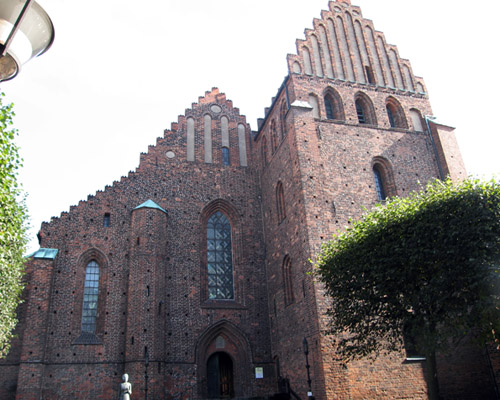| Mariakirken i Helsingborg

| | Sancta Maria i Helsingborg har en lang bygningshistorie. I sin grundform var den færdig i 1410. Kirken er, som sin pendanti Helsingør,opført i gotisk stil og indeholder en række kunstskatte, ikke mindst fra middelalderen |
Sancta Maria Kyrka
Den senmiddelalderlige kirke ligger midt i det gamle Helsingborg. I det 21 århundredes Helsingborg er den ikke nogen dominerende del af bybilledet og synes nærmest ikke fra søsiden. Kirken er faktisk lidt svær at opdage, men når man står foran den, må man beundre skønheden i den gennemførte gotiske byggestil.
Træder man indenfor er en række af Helsingborgs senmiddelalderlige kirkekulturs interiør bevaret.

Mariakyrkans østlige facade |
Gotik
Sancta Maria Kyrka stod færdigbygget i 1410 efter en lang byggeperiode på ca. 100 år. Den er opført som en basilika og har nærmest karakter som en lille katedral. Midtskibet er, i lighed med de store gotiske katedraler i Europa, lavt og har ingen vinduer under hvælvet. Byggestilen omtales ofte som: en halv basilika eller en ”pseudobasilika”. De samme karakteristika kan i øvrigt iagttages på den anden side af Sundet, hvor Mariakirken i Helsingør har samme arkitektoniske træk.
De gotiske træk er fremtrædende, de spidsbuede vinduer og de spidsede hvælv er endnu fremtrædende. Som man også kan se det i eksteriørets trappestensgavle og de udvendige støttepiller, som holder kirken på plads.
Kirken erstattede en tidligere romansk sandstenskirke fra 1100-tallet. Og med sine, i forhold til tidens små huse i Helsingborg, blev den med sit gotiske teglstensbyggeri et markant og dominerende bygningsværk i byen. Der var flere kirker i byen, men det var kun Kärnan og Nicolaiklosteret, der kunne konkurrere med Sancta Mariakyrkan om den bygningsmæssige dominans i Helsingborg.

Mariakyrkans vestlige facade | 
Mariakyrkans støttepiller | 
Maria Kyrkans hvælv | 
Helsingborg model 1400 |
Middelalderens kunstskatte
Døbefonten er fra 1300-tallet og er hugget ud af gotlandsk kalksten. Oprindeligt har den været malet og videnskabelige undersøgelser påviser fragmenter af rød og blå oliemaling.
Altertavlen/Skabet er i en bemærkelsesværdig god stand. Den er malet på samme tidspunkt som kirkens indvielse. Nemlig i perioden 1449-1452. Antageligt af en mester fra Stralsund. I centrum af tavlen dominerer scenen med Maria og det nyfødte Jesusbarn. Motiverne omkring dem er fra Jesus liv og virksomhed, som det beskrives i Det nye Testamente.
Altertavlen, som er udformet som en slags skab, kan lukkes sammen på visse tider af kirkeåret. Bl.a. under fasten. Her må tilskueren undvære skulpturerne og nøjes med at betragte motiver fra Jesus sidste tid. En af disse scener viser, hvorledes Jesus driver kræmmerne (købmændende) ud af templet. En interessant detalje hér er, at nogle mønters udseende i dette motiv kan stedfæstes til Stralsund. En detalje der gør, at man antager, at alterskabet er produceret af en mester i denne by.
Triumfkrucifixet i gotisk stil er fra den seneste middelalder. Nok så interessant er, at der står 1753 ved korsets fod. Men angiver kun tidspunktet for da krucifixet blev malet om /restaureret. Dette kompliceres videre af at selve korset er fra en senere tid end selv krucifixet. Krucifixets ophavsmand er ukendt, men eksperterne antager, at det er tilvirket i den sydlige del af Skandinavien.
En senere tid har fjernet det oprindelige puds, som kirkens indvendige vægge var beklædt med. Nu fremstår væggene som teglstesnvægge. Bag ved alteret er der dog endnu rester tilbage af den gamle puds, hvor der er fragmenter af de gamle kalkmalerier. Bl.a. af helgene: S:t Magnus og Brandanus. Kalkmalerierne er fra 1400-tallet blev udført af den såkaldte: Helsingborgmester, hvis noget mere velbevarede kalkmalerier kan beses i Brunnby Kyrka på Kullahalvøen.
Fra middelalderen findes også det såkaldte piscinan nederst i korets væg.

Maria Kyrkans altertavle | 
Det lukkede alterskab | 
Kræmmerna drives ud af templet | 
Maria Kyrkans krucifix | 
Maria Kyrkans døbefont |

Maria Kyrkans kalkmaleri | 
Maria Kyrkans piscina |
En ny tid på vej
Tårnet til kirken blev først færdiggjort omkring 1500. Altså ved indledningen af det århundrede, som ikke blot skulle forandre kirkens organisation og dogmatik i Norden, men også det, som en senere tid har kaldt, Middelalderen.
Maria Kyrkans middelalderlige oprindelse er dog stadigvæk særdeles markant. Og dette på trods af senere moderniseringer med prædikestol, orgel og bænkerækker. Kirken er, med rette, betegnet som et eksempel på, hvad middelalderen stadigvæk kan præsentere os for af stilfuld arkitektur, dygtige bygningsarbejdere og fantastiske kunsthåndværkere. |